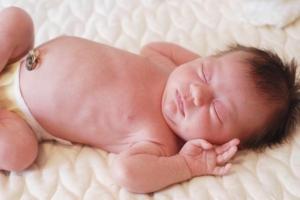Recently, a concerned friend sent me a note asking if I would write a blog reminding parents and grandparents about the importance of placing a baby on its back to sleep, a position that could save their babies life. She said she was worried about the recent photographic art trend that shows cuddly cute babies napping on their stomach. In the pictures, little newborns are scrunched up on their belly with knees almost to their chest looking adorable. At first glance, what could be wrong with that peaceful image? Without mincing words, sleeping on the belly is linked to sudden infant death syndrome or SIDS. SIDS is the leading cause of death of all babies from newborn to twelve months old.
How does that happen? The theory is that when the baby is on its belly he or she is getting less oxygen and has a reduced ability to get rid of enough carbon dioxide to keep breathing. The exact reason for this happening is not clear, but may be related to re-breathing air from a small pocket because of blankets pulled up around the nose. The brain, at this early age, is not developed enough for the baby to awaken and to be able to move to resolve this dangerous positioning. The result could be horrendous.
Reduce the risk of SIDS! The good news is that by placing a healthy baby on its back to sleep, the risk of SIDS is greatly diminished. The American Academy of Pediatrics (AAP) published this recommendation first in 1992, after research demonstrated that babies placed on their stomachs were at a greater risk of dying in their sleep. The AAP confirmed this recommendation in 1994, 2000, 2005 and as recently as 2013.
There are other watch-outs when placing the baby on its back to sleep. The site, healthychildren.org says it is important to avoid placing the baby on soft, porous surfaces such as pillows, quilts, comforters, sheepskins or been bags. A firm crib covered by a sheet is the safest bedding.
Next time you place the baby down for a nap or the night, remember BACK TO SLEEP! Without a doubt you both will rest better.
Visit healthychildren.org for more guidance on keeping your baby healthy.

Leave a Reply